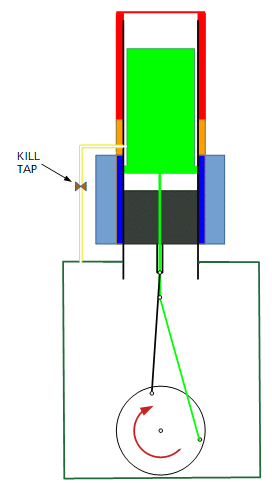Page 40 – The Kill Tap and Speed Control
Over the two hundred years
since the invention of the Stirling engine, there have been
many
and various methods developed to vary the speed of the
engine.
Some of them rather complicated.
Philips
installed a Stirling in a 25ft cabin cruiser called “Jan de
Witt”.
There is even a You Tube
video
of it. (Wait till minute 3:22)
It's part 2 of a long video – part one is also
very well worth watching
Their method was to vent the
pressurised helium to a reservoir and then pump it back to
the
engine when required.
It clearly worked, but I would
class it as an “engineer’s solution” which
involved
“ever more complicated engineering”.
The
UK Stirling group have developed a far simpler method.
A
pipe, with tap, is used to connect the gas above the piston with
the gas below the piston.
When the tap is partially
opened, the high pressure which would otherwise be used to
push
the piston, is allowed to escape to the crank case. The
pressure on the piston is reduced.
The power and speed of the
engine is reduced.
When the tap is closed, power is
restored immediately.
No need for a pump to rebuild the
pressure.
When
the tap is fully opened, the pressure above and below the piston
is equalised.
There
is no force on the piston. The engine stops.
For fine
control of the engine speed, a needle valve is needed.
